The Return of V8 Shorthorns:
A New Generation of Passionate Breeders
Well, we did it! We bought a Shorthorn!
This isn’t our first Shorthorn. In fact, after reactivating my American Shorthorn Association membership, I found that under the “legacy” tab, a total of 378 Shorthorn cattle have passed through my account in one way or another.
At the height of our operation, V8 Shorthorns had nearly 100 breeding females on our Texas Gulf Coast ranch. From 1986, when we purchased our first Shorthorn, until around 2016, we proudly managed one of the southernmost herds of Shorthorn cattle in the United States. We were fortunate to have a strong market for our Shorthorn bulls and replacement females, and we marketed our top show heifer prospects through our friends and fellow Texas Shorthorn breeders, WHR Shorthorns, who graciously allowed us to partner in their Lone Star Edition sales for many years.
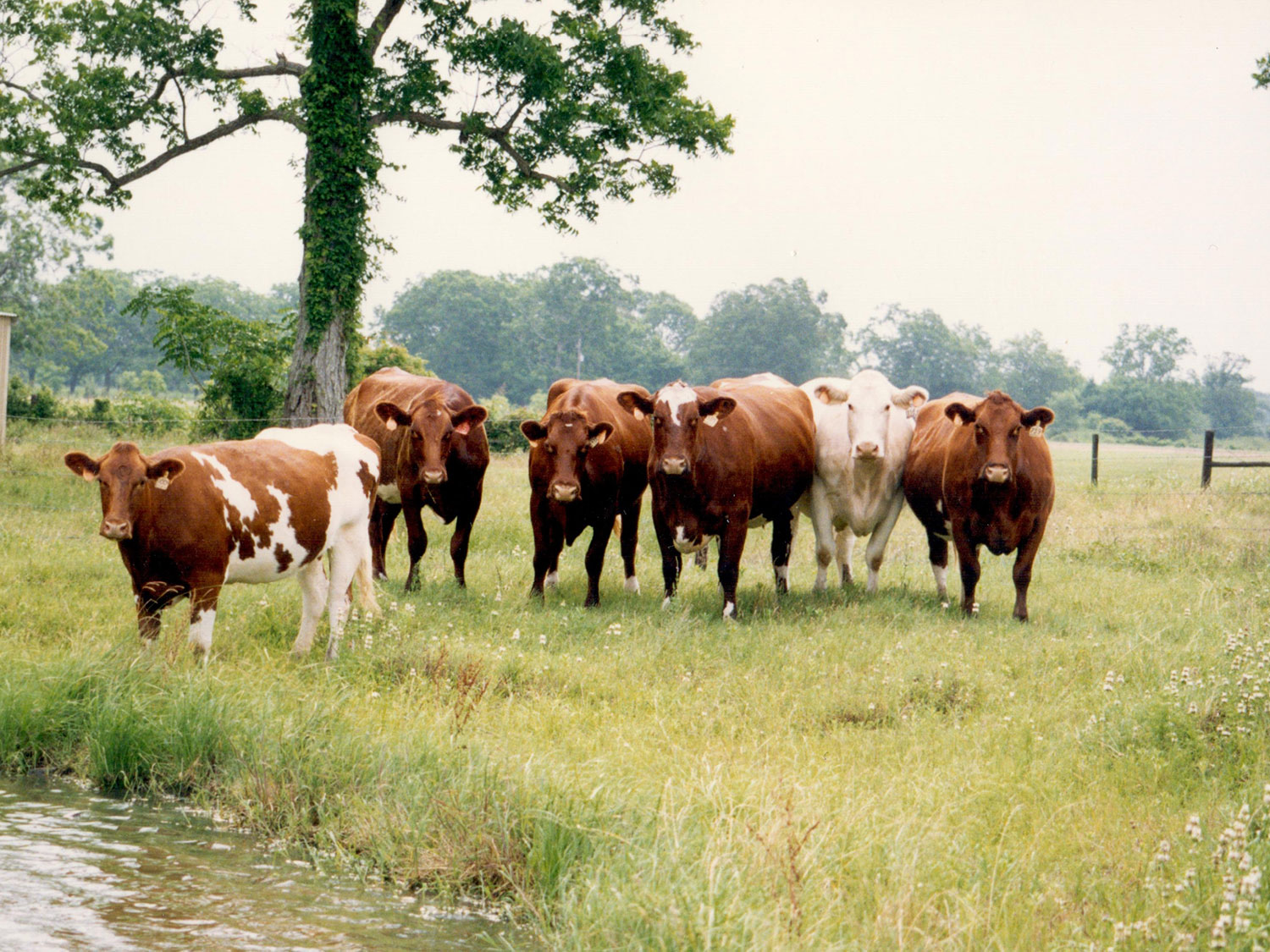
Why Shorthorn Cattle?
How did we get into Shorthorns? The simplest answer is that my father, Jim Williams, became an admirer of Shorthorn cattle after seeing them across the show ring when he was judging in Oklahoma. I was only three years old when we got into the breed, so I’ve never known life without Shorthorns.
Dad has always believed in the power of good females and building around cow families. Our Brahman cattle herd was built the same way—a process refined over decades. When the Shorthorn itch hit him, he went into research mode, as he always does. He set out to identify the 10 best Shorthorn cows in the USA and built our herd’s foundation from them.
There’s a journal in his desk from that time, filled with handwritten notes about Shorthorn females who are now legends in the breed. He sought advice from the top minds in the industry, most frequently Dr. Roger E. Hunsley, asking for their “wish list” of females they would want to own. He then tried to buy those cows or their daughters.
Although it may not have been explicitly stated, I can see now that the Shorthorns were a hobby—a creative outlet for our family away from our core business of Brahman cattle. Brahmans are our family’s livelihood and work, and we love what we do. We are constantly working with our Brahman herd, even today. But the stakes and pressure are high. We could have taken on a different hobby, like boating or camping, but what do cattle ranchers do when they need a hobby? In our case, we got another breed of cattle to chase as a hobby.
What we could never have anticipated was how much this ‘hobby’ would give back to our family. The Shorthorn people welcomed us with open arms from day one. Most Shorthorn farms are small, family-run operations, primarily in the Midwest, where the climate suits Shorthorns. The people who gravitate toward this breed are salt-of-the-earth—mom-and-pop operations that feel like home.
Shorthorn Cattle – A Personal Passion
Our first Shorthorn show heifer, Granada Cumberland 9172—whom we called “Star”—became my first Shorthorn friend. Even though we had a large show barn for our V8 Brahman breed show cattle, our family had a smaller show barn in my parents’ backyard. Every day, we worked together with my sister’s show cattle, and I always got to lead Star. I showed her in pee-wee showmanship all over Texas, and we used to joke that Star thought she was an American Brahman.
I wasn’t old enough to officially show cattle at the time, so technically, Star was my sister’s heifer. But at six years old, I truly believed she was mine. Somehow, by the time she was done showing, I did end up owning her! According to the registry, Star was transferred into my name on April 1, 1991.
Our mentors in Shorthorn cattle were Mr. and Mrs. Buchholz, who operated Buchholz Brothers Shorthorns in Bardwell, Texas. They were top breeders and were generous with their advice for rookies like us. When we prepared Star for the Fort Worth Stock Show, their instructions were simple: grow as much hair as possible. We arrived at the show with a very hairy, unclipped heifer that no one gave a second glance. The Buchholzes had their crew clip her, and the next day, she was champion. We were hooked.
My own first Shorthorn show heifer was HWS Hazel A90, or “Sweet Pea,” raised by the Schilling family. Her best trait was her gentle disposition, which made her perfect for a first-year showman like me. Sweet Pea and I collected many participation ribbons, but she had a special place in my heart because she was so gentle. For two years, my mother kept a crock pot in the kitchen, cooking corn for her because she was that hard-doing. By her last show, Sweet Pea ended up as Champion at the State Fair of Texas. That banner belongs to Luann Williams. 🙂
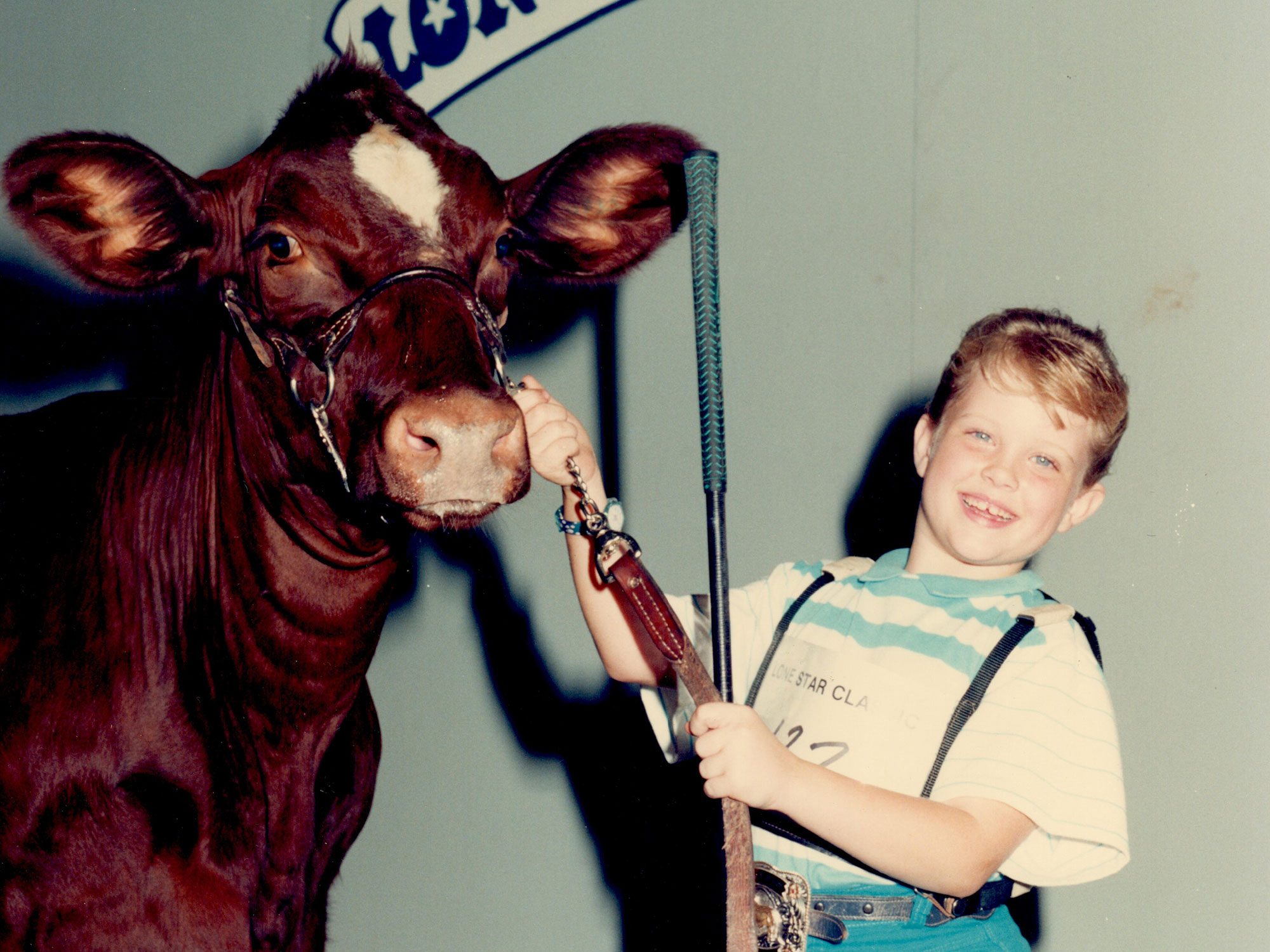
My first shorthorn show heifer
Sweet Pea & I posing at the backdrop at the Lone Star Classic in Brenham, Texas in 1991.
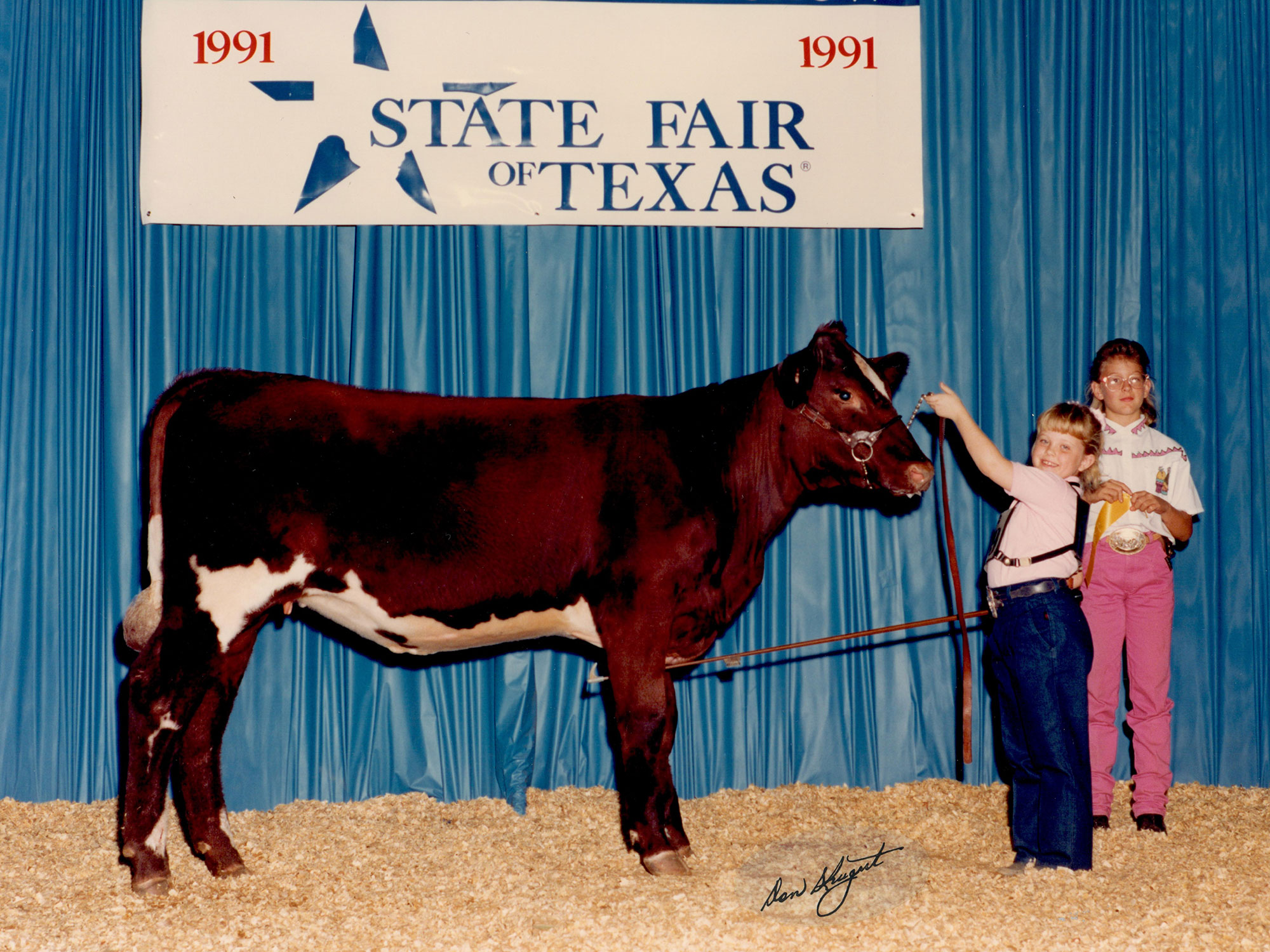
HWS Hazel A90
My first time exhibiting at the State Fair of Texas. Notice the participation ribbon.
By this time, my sister was showing some “warhorse” Shorthorn cattle, as well as the top Brahman cattle from V8. I had little Sweet Pea. I noticed that when it was time for my sister’s heifers to go to the ring, a whole entourage followed them. But when it was Sweet Pea’s turn, it was just me and my parents. My sister’s heifers, like AF RDS Margie 035, who was Champion in the Junior Show at Louisville, and EHS Rosey’s Passion, who won the Denver Junior Show, were always in the hunt. I was along for the ride, but I distinctly remember telling my parents when I was 8 years old, “I want a heifer everyone follows to the ring.”
"I want a heifer everyone follows to the ring."
Catherine Williams Neumayr
I only recently learned the full story of how I ended up with a better heifer. I remember Dad telling me back then that he had found me a great one and had gone on a quick trip to get her, but I didn’t know what had really prompted it.
We had been showing Sweet Pea at Texas prospect shows, and during a two-day show in Brenham, Texas, Sweet Pea placed last—4th out of 4—on the first day. Dad said I took it in stride, not overly disappointed, as I was used to those kinds of results. But on day two, by some miracle (or maybe just an inexperienced judge), Sweet Pea won her class, beating the same heifers from the day before.
Dad told me that when he saw how happy I was with that win, he knew it was time for a change. I didn’t know it then, but that moment set things in motion.
That evening, after we got home from the show, Dad drove straight to the Houston airport, without a ticket, and caught the next flight to Springfield, Illinois. The Illinois State Fair Shorthorn show, one of the most competitive in the country at that time, was happening the very next day, and Dad spent the entire day watching, on the lookout for a gentle heifer who could be my ‘warhorse.’
At the time, Dad had just formed a friendship with Don Cagwin, who had a top heifer being shown by Andy Rahn. Her name was CCS Lady Temptation 81Z, a daughter of HS Rodeo Drive 062WR, an emerging Shorthorn sire of champions. The problem? She was already photographed and cataloged as Lot 1 in their upcoming production sale. After some tough negotiations, the Cagwins and Rahns agreed to sell us “Tempy.” She stayed in the Midwest, finishing out the state fair circuit, shown by Mr. Buchholz after we purchased her.
I remember the day Dad came home from the airport, excited to tell me he had found me a great heifer. At the time, I had no idea what had led to that trip, but I was thrilled. That moment stands out as a significant turning point—a priceless core memory. I could list all of Tempy’s wins, but what I remember most is that suddenly, everyone followed me to the ring. I won my first belt buckle with Tempy at the Turkeyfest Extravaganza in Cuero, Texas, and from that moment on, things were different.
Finding My Place Between Two Breeds
Much to my family’s dismay, I only wanted to show Shorthorns. They tried their best to ensure I showed Brahman cattle too—I always had a bred-and-owned Brahman cow alongside my Shorthorns. For the first couple of years of my junior show career, they encouraged me to show Brahman cattle at the All-American and the state show.
I had such a ride with Shorthorn cattle. I was a Shorthorn person. I am a Shorthorn person. Many Brahman people either knew this about me or, more fittingly, didn’t know me very well because of it. For a big portion of my life, I was behind the scenes when it came to our Brahman cattle operation because I was on the front lines building our V8 Shorthorn program.
As a young Shorthorn cattle breeder, I experienced a level of success most people only dream of. I exhibited the Grand Champion Heifer at the Shorthorn Junior Nationals three years in a row, something never before done, and not since. In 1999, I showed LF Roan Princess 98, followed by CF Myrtle Bo 93 TPX in 2000, and WHR Cumberland 9R86 in 2001. My dad wore the same shirt on all three show days, and each night before the show, we had dinner at Bob Evans Restaurant. Why you may ask? The truth is, after that first illustrious year, we got a little bit superstitious and decided to keep as much the same each year as we could. Looking back now, I prefer to see it as a V8 family tradition being born. Each of these heifers represented not just victories in the show ring, but years of dedication and the strong foundation my parents laid for something very special we could experience together.
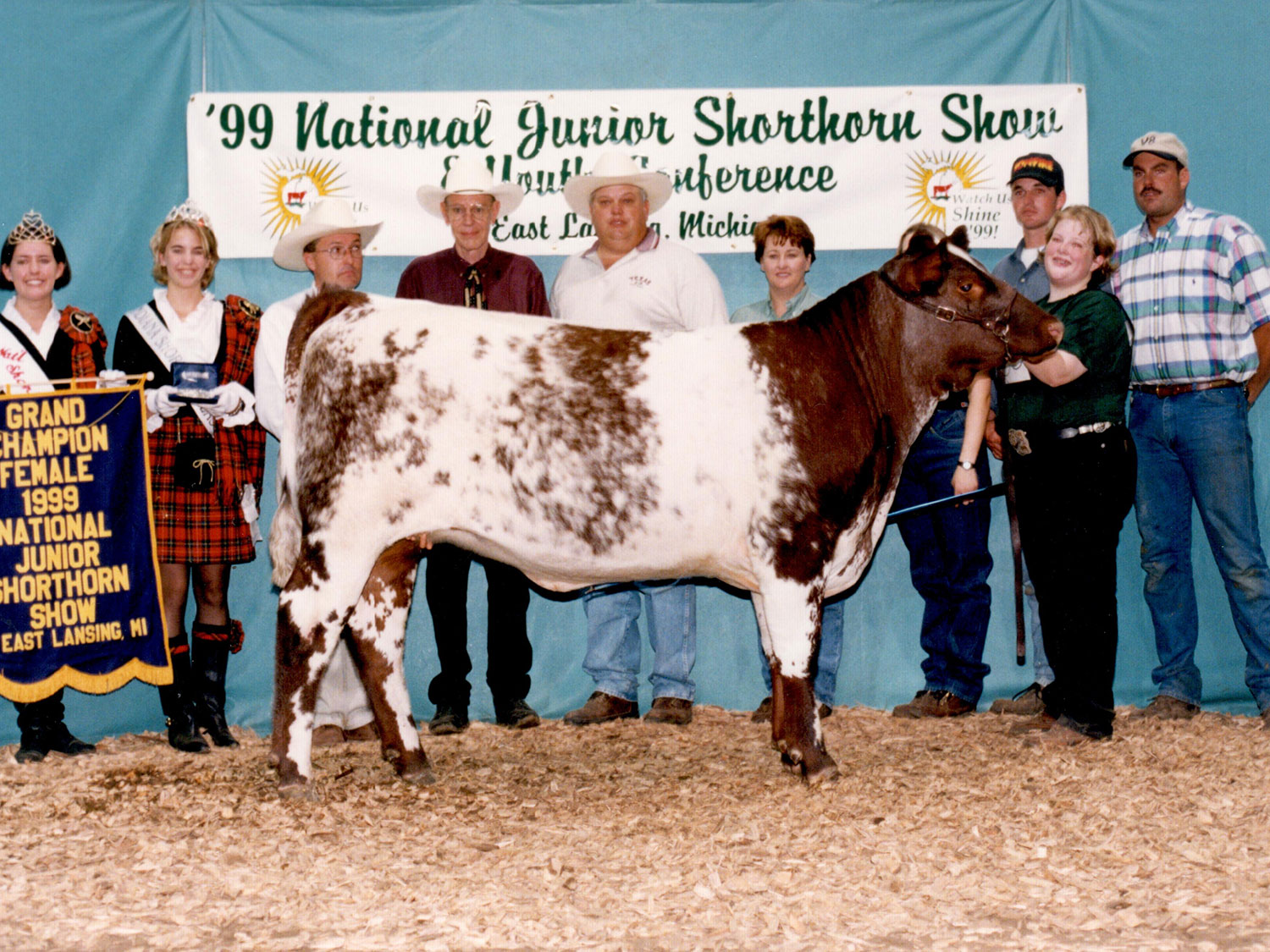
LF Roan Princess 98
Grand Champion Female, 1999 National Junior Shorthorn Show
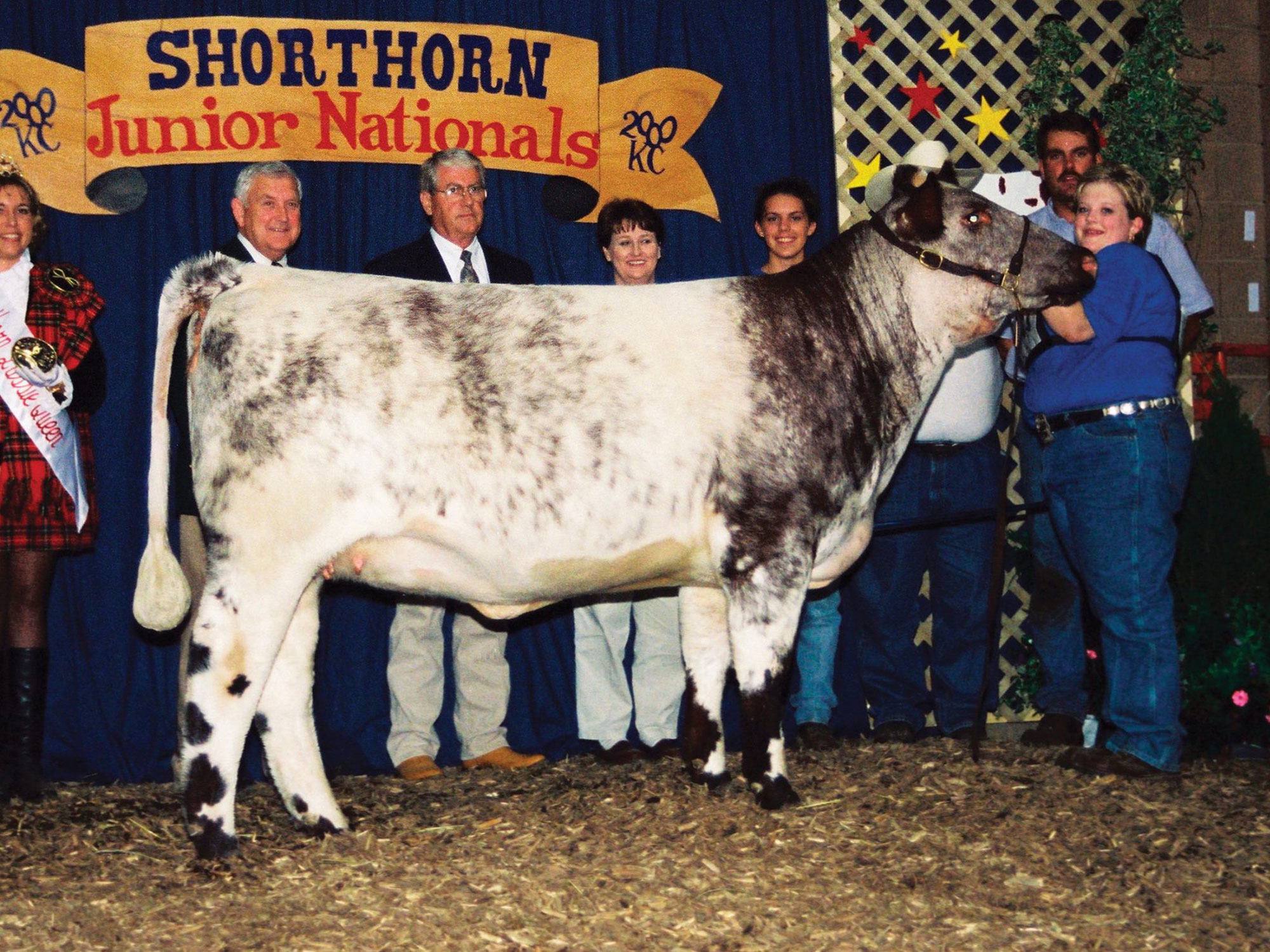
CF Myrtle Bo 93 TPX
Grand Champion Female, 2000 National Junior Shorthorn Show
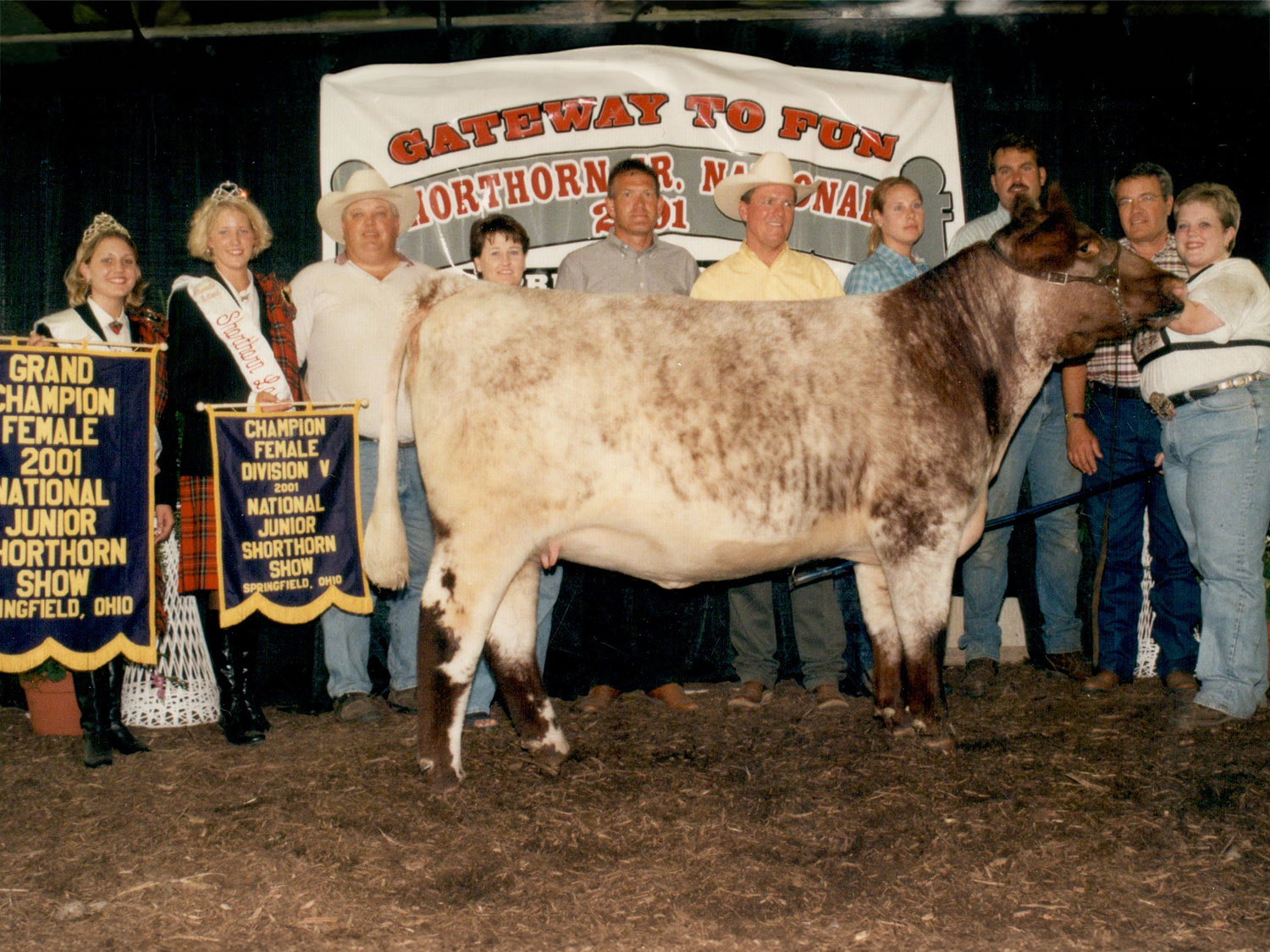
WHR Cumberland 9R86
Grand Champion Female, 2001 National Junior Shorthorn Show
Our dominance in the Shorthorn breed extended beyond the Junior Nationals. From 2005 to 2014, V8 Shorthorns consistently earned the titles of Show Heifer and Show Bull of the Year. We had multiple Show Heifer of the Year titles, with Miss V8 Can’t Fool Me 458N2 in 2005, Miss V8 Dionne D 50R7 in 2007, and Miss V8 Mollie Jo 93S2 in 2008. That same year, we claimed both titles, with Mr. V8 D’Brickashaw 115S2 winning Show Bull of the Year. In 2009, Miss V8 Mona’s Hip Hop ET earned Show Heifer of the Year. In 2014, CF V8 Fascination X was named Show Bull of the Year, though we can’t claim him entirely as our own, as he was part of the era when the Cates were managing our genetics for us.
During these times, our show cattle were managed by Cary Aubrey and later, Travis and Beth Pembrook. All were partners in our success and share these memories and achievements just as much as we do. These victories are theirs as much as they are ours.
Our Shorthorn cattle operation had grown so much that, at our peak, we brought 18 head in our show string to Louisville—an experience that still stands out to me.
In 2000, after several heifers claimed the reserve spot, we exhibited our first National Champion Female, CF Myrtle Bo 93 TPX, raised by Cates Farms. Then, over 20 years after getting into the breed, the first ‘Miss V8’ home-raised female, Miss V8 Mona’s Hip Hop ET, was named National Champion in 2008. There is no such thing as an overnight success.
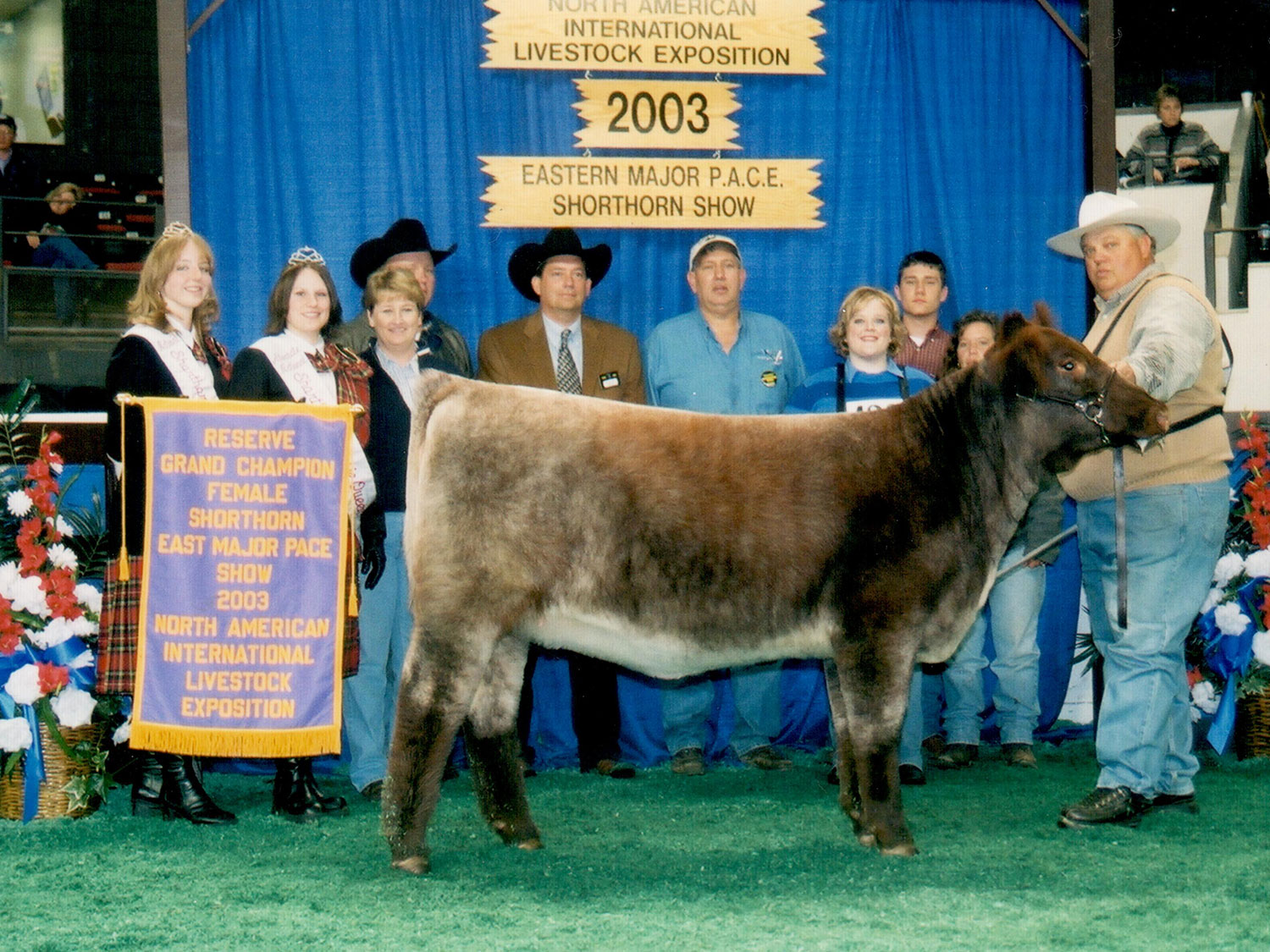
MISS V8 CAN'T FOOL ME ET
2005 ASA Show Female of the Year
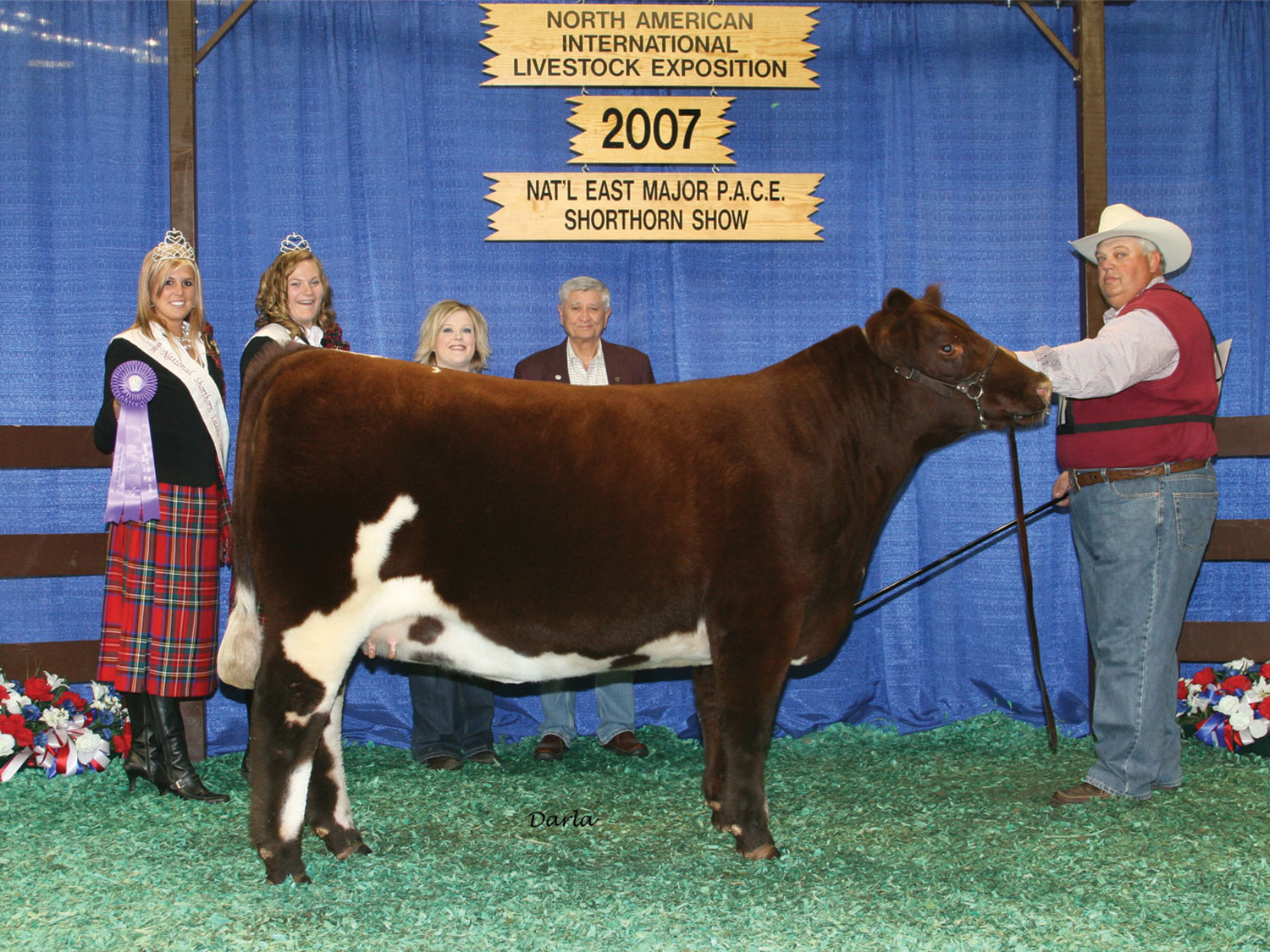
Miss V8 Mollie Jo 93s2
2008 ASA Show Female of the Year
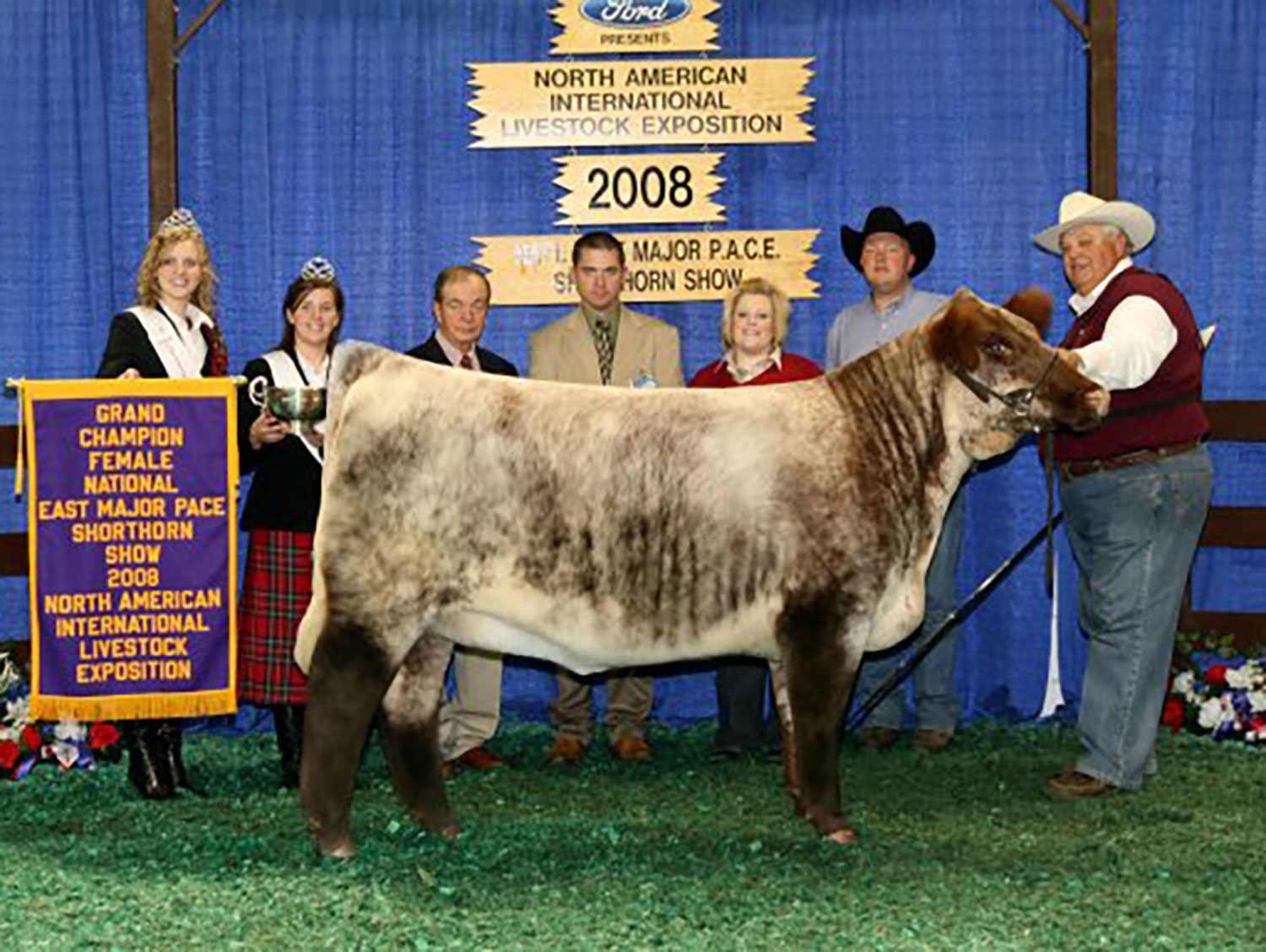
Miss V8 Mona's Hip Hop ET
2009 ASA Show Female of the Year
A 10-Year Hiatus from Shorthorns
Why did we step away from Shorthorns? The official answer, and the simplest, is that the South Texas weather became too harsh for them. A terrible drought forced us to relocate our Shorthorns to Indiana, where they joined the Cates Farms herd. But the unofficial answer is more complicated and nuanced. Our family dynamics were changing, and we weren’t quite sure how to navigate those shifts.
In my own life, I had stepped away from agriculture. Luke’s and my wedding photography business had grown so much that it took most of my time and energy. I felt like I was juggling too many things—family dynamics, our photography business, and ranching. The Shorthorns had always been my thing, and when I took a step back from agriculture, they became the casualty. Without me being all in, they faded.
Looking back, it was a mistake for me and my priorities to leave the Shorthorn business. The cattle and the people meant too much to me to ever walk away. I’ve learned that you should never let go of something you truly love. There was always a part of me that felt like it was missing. When our son was born, it became even clearer that I needed to find my way back, not just for me, but for him. I showed him photos of Shorthorn cattle, and since he was old enough to talk, he said, “I’m going to show Shorthorns.”
Leaving Shorthorns wasn’t all bad, though. In fact, it opened up new opportunities and perspectives that I wouldn’t trade for anything.
Everything happens for a reason, and my 10 years away from Shorthorn cattle allowed me to finally appreciate the beauty and wonder of the American Brahman breed I’ve known my whole life. If I hadn’t stepped away, my heart might never have been open to them because, for so long, I held that core belief that I was a Shorthorn person.
Brahman cattle, though, are undeniably part of who I am—they are in my blood. I now understand that Brahman cattle can be just as gentle as Shorthorns, sometimes even more so. Brahman cattle love and crave attention from people in ways that Shorthorns often don’t. On any given day, I can walk up to 20 Brahman cattle on our ranch and scratch them all over in the pasture. But when I think back on my time with Shorthorns, I can only remember one cow that would let me pet her in the pasture.
And the Brahman people—just as wonderful as those in the Shorthorn community—have become lifelong friends.
Staying Connected and Returning Home
Since around 2021, I’ve been watching the Shorthorn world from afar. I’ve tuned in to every major show on the livestream, and though I wasn’t in the ring, I never felt disconnected. I’m so grateful to have maintained many of my friendships in the breed, and those relationships kept me from feeling like a total has-been. There was never any doubt where we’d go when it was time to get back into the breed. The Cates family had taken in our cattle when they left the ranch, and thanks to their expert management, the “CF V8” cattle they raised and marketed kept our prefix known in the Shorthorn world. Some people might have seen that V8 in winning cattle names and wondered who we were.
The kindness of the Cates family has meant everything to us over the years. Tyler Cates and I grew up together showing Shorthorns, and he’s graciously tolerated my tire-kicking about Shorthorn cattle for the last several years—trying to stay informed and understand the breed’s ins and outs while not being an active player.
As we prepared for Knox’s first Shorthorn Junior Nationals this year, Tyler and Cortney welcomed us with open arms, letting us use their stalls as our home base. Their daughter, Piper, and our son, Knox, became the third generation of Cates/V8 friends, carrying on the legacy that started with their grandfathers, Jim Williams and Brian Cates.
Watching the Cates family in action, seeing how they treat their customers with integrity and class, only solidified our decision to return to Shorthorns. They run a first-class operation with impeccable ethics—always putting their cattle and clients first. The hard decisions they make, like having Piper show only bred-and-owned animals in the bred-and-owned shows to not compete with their customers, demonstrate their commitment to doing things the right way. They don’t just talk the talk—they walk the walk.
These are the people I want to be our mentors as we step back into the breed—and the mentors I want for our son.
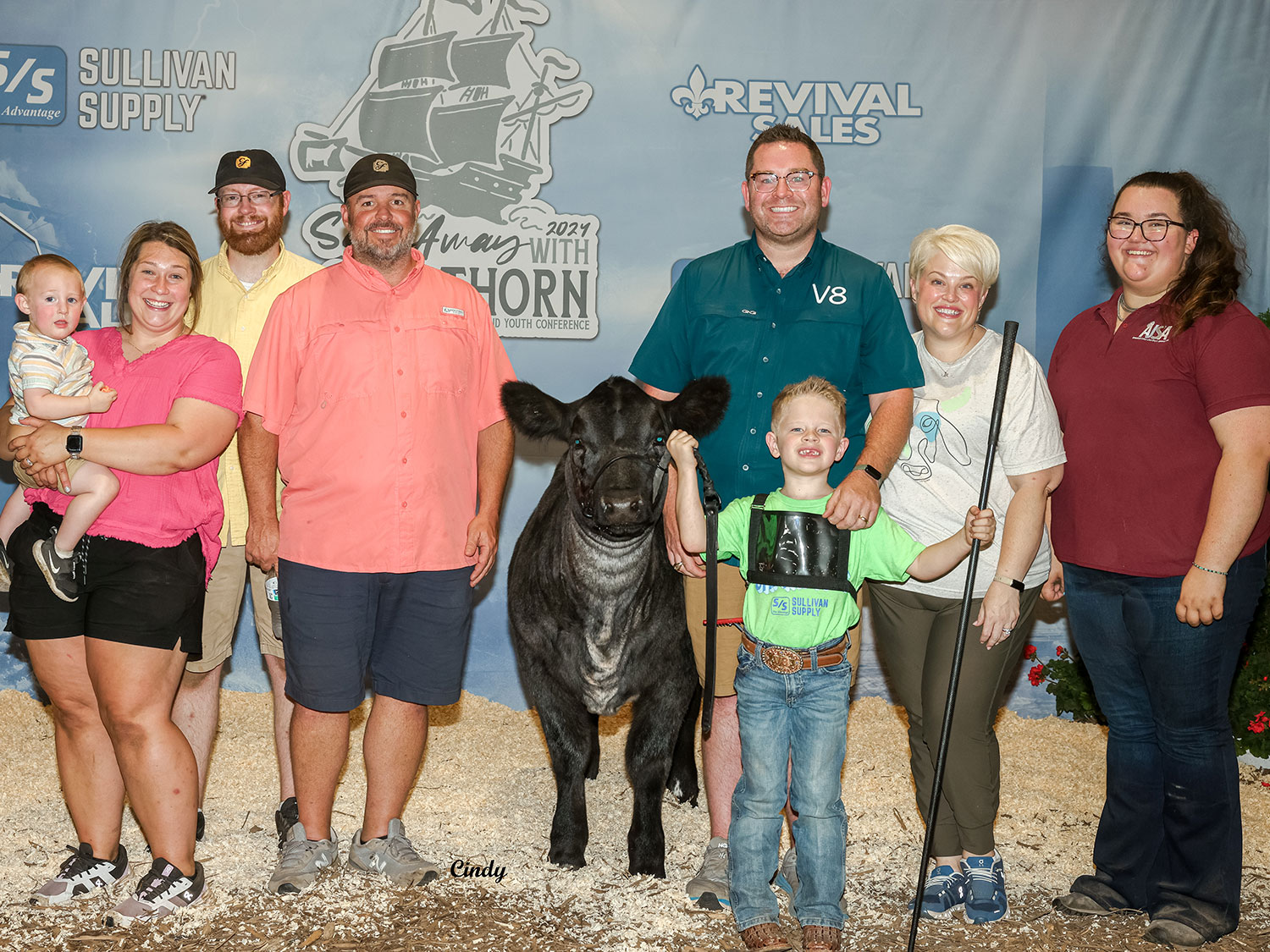
Cates Farms & V8 Shorthorns
Tyler Cates and his wife Cortney hosted us in their stall throughout the competition while Knox and Piper ran around together.
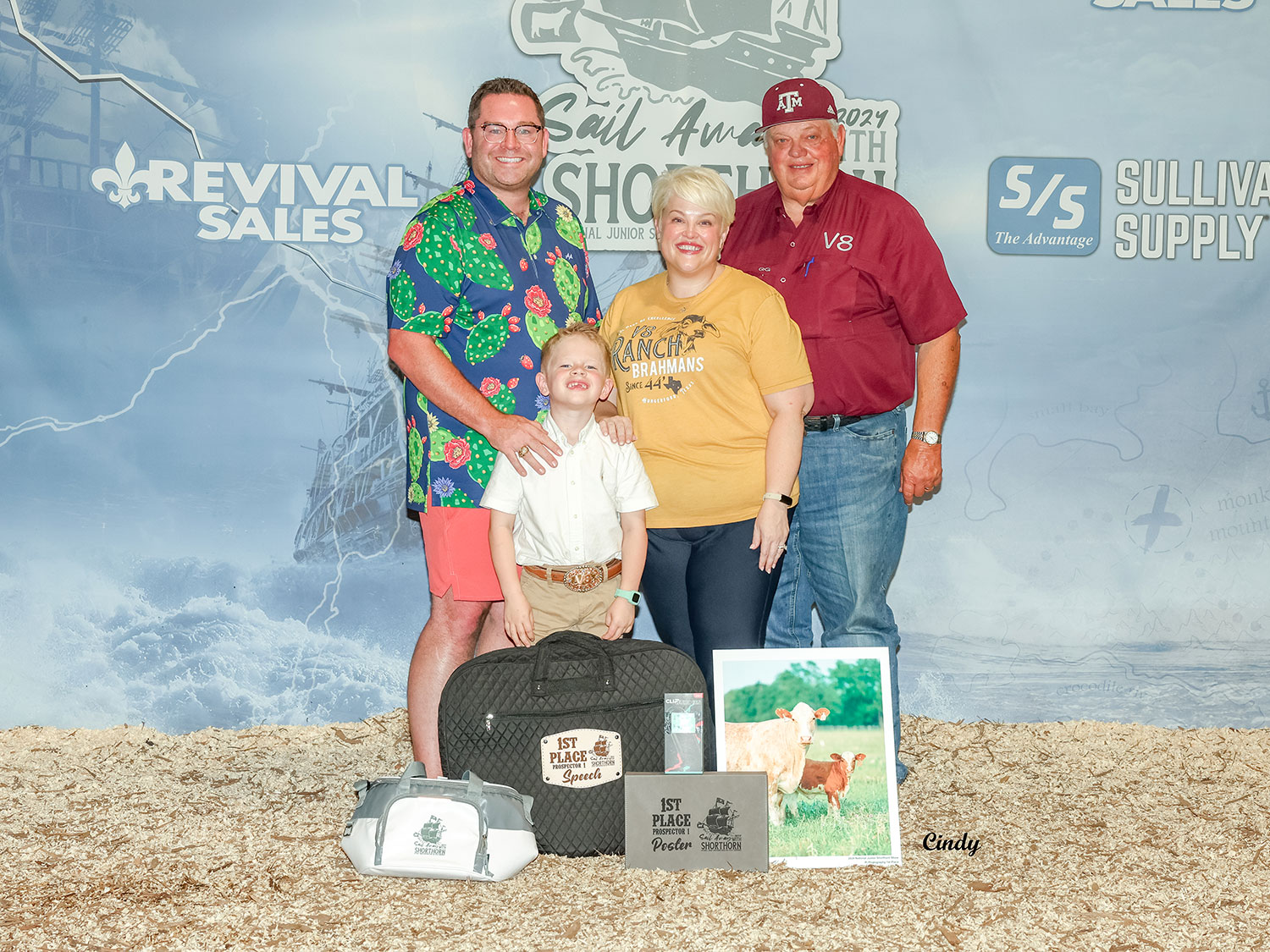
V8 Shorthorns at the 2024 NJSS
Only missing Luann, our family enjoyed our return to the NJSS. This was the 20th year V8 Shorthorns attended.
A New Chapter Begins: Knox’s First Shorthorn
Getting Knox his own Shorthorn has been a couple of years in the making! This summer, the 2024 Shorthorn Junior Nationals were the perfect trial run for what I hoped would become Knox’s love for Shorthorn cattle. I’ll never forget the first time he saw a fluffy Shorthorn cow in person—it was, dare I say, love at first sight (or touch). Remember when I said Brahman cattle are in my blood? Well, Shorthorn cattle are in Knox’s blood, too.
Before we knew it, “the” sale was upon us. Exactly one year ago, over Labor Day weekend 2023, I was at the Sugar Classic in New Iberia, Louisiana, watching the Brahman show while my mom and dad were at the ranch, tuned into the Cates Sale livestream. We were ‘play buying’ that day—picking out the heifers we’d be interested in if we were actually buying and closely tracking what it would take to make those kinds of purchases. At this year’s Junior Nationals, I found myself running my phone battery down during the show as I looked up heifers I liked, checking their past sale prices to get prepared.
In 2024, the plan finally came together. Mom and Dad made the 18-hour drive from South Texas, leaving the ranch in Boling on Wednesday and heading to Modoc, Indiana. The three Neumayrs flew in on Friday morning. Luke’s mom picked us up from the airport, and that evening, we headed out to the sale. We walked through every pen. As we moved up and down the rolling hills of the pens, I couldn’t help but be grateful Dad had his knees replaced! We carefully looked over each Shorthorn heifer and stayed until the sun went down.
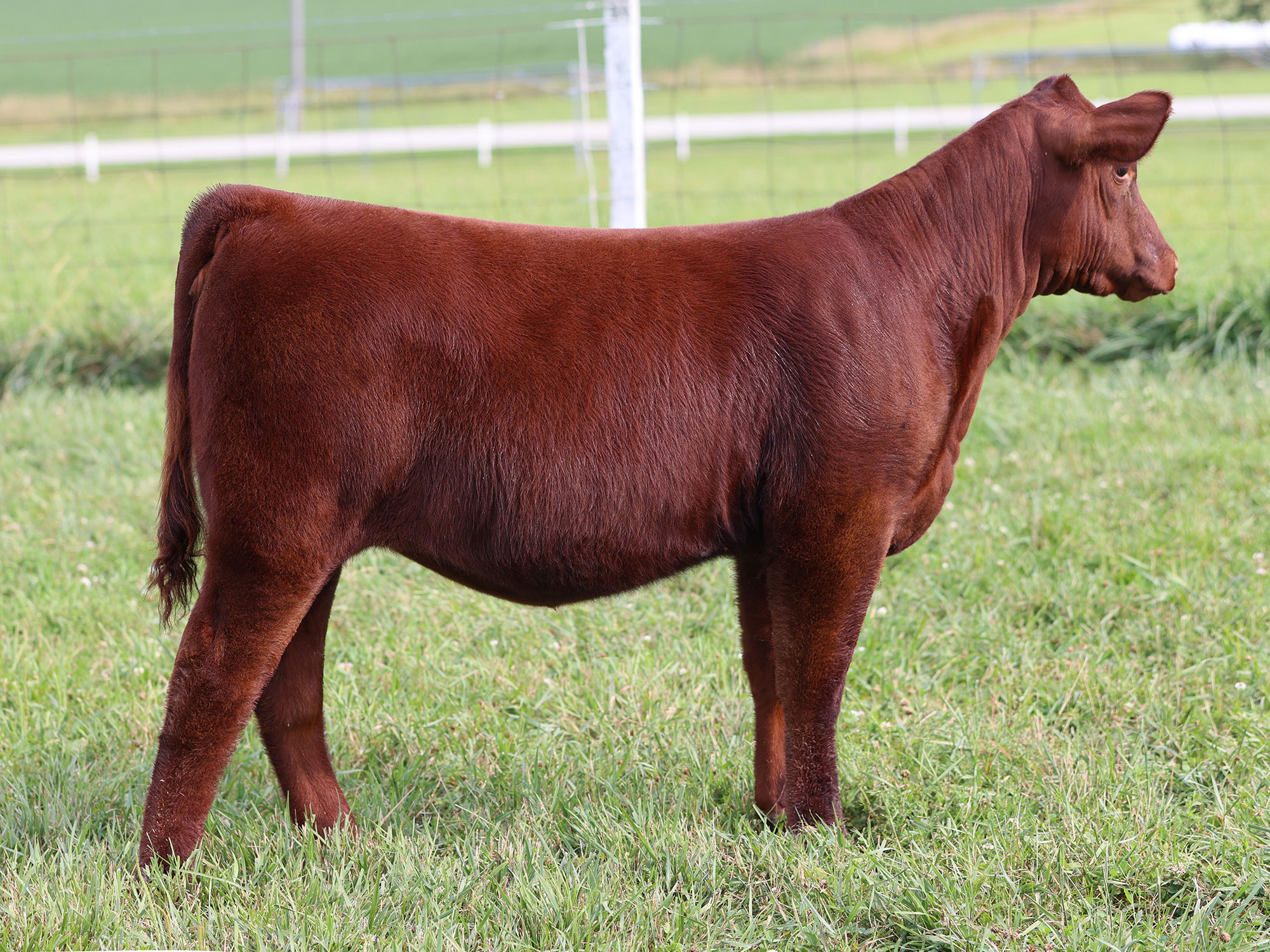
CF PC MARGIE 476 EV X ET
Photo of Margie from the Cates Farms Star Search XXII catalog.
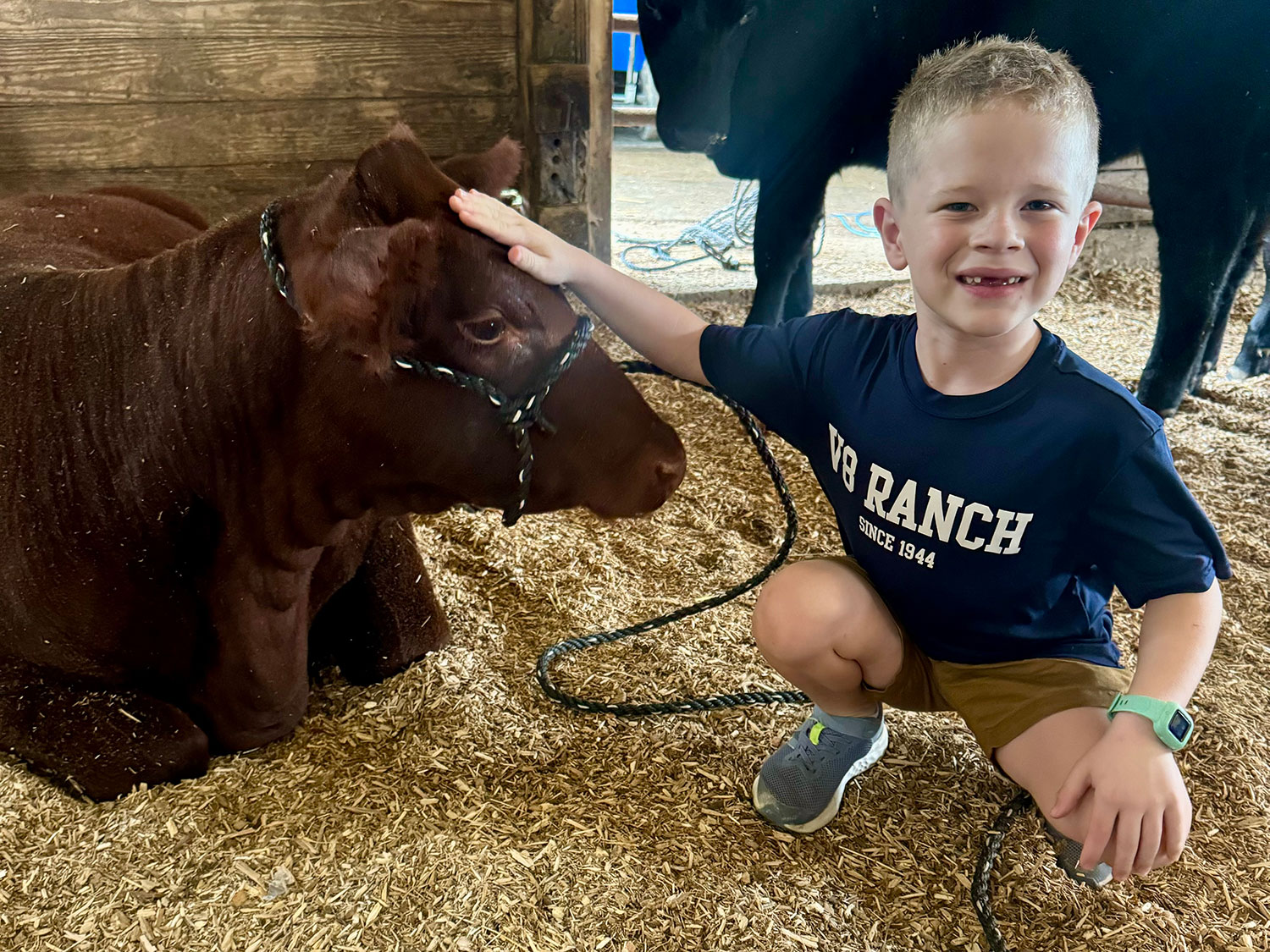
Love at first sight
Knox’s new best friend, Margie enjoying some downtime after the sale.
We had our eyes on a couple of heifers in the sale, and I had been texting Tyler about them. Several factors were at play: age (since that affects how they compete against other heifers in the same sale), color (we wanted roan), and, most importantly, disposition. While all Shorthorns have a gentle disposition, some are definitely gentler than others. Early on in this journey, Tyler advised me that for a first-year exhibitor, the most important thing is a gentle heifer to ensure a good experience.
All my time away from Shorthorns has given me the luxury of not being too focused on pedigrees anymore—how crazy is that? I left the Shorthorn world with years of meticulously planned matings for our cows. I knew every AI sire in the breed and could picture nearly every show ring contender from the last 20 years. But any pedigree bias I had back then is now generations away.
The first pen we walked into, I rounded the corner and immediately spotted a heifer I liked. A solid red heifer, she reminded me of my all-time favorite Shorthorn show heifer, WR4 Delila D R750, whom Bill Rasor from WHR Shorthorns had sold us private treaty after his daughter Ann Rasor Wells showed her as a calf at her last junior nationals. From all the catalog and video studying I had done, I knew she was Lot 14A. Her name was “Margie,” and I recognized it right away as one of the oldest and most respected cow families in the breed made famous by the Aldens. V8 has owned Margies before, back in the early days. She let me pet and scratch her immediately. I walked right up to her, and oh, what a feeling! We studied her from every angle. She was so gentle we actually had a hard time getting her to even walk around the pen. We looked at every other heifer in the offering, but she was the only one we took Knox to see. Just before dark, we returned to Margie’s pen. He held out his hand, and Margie walked right up to him. It seemed she had chosen him too.
The next morning, we arrived at the sale by 8:00 AM to reserve our spots for the 10:30 AM auction. I hadn’t been to a Cates sale in 13 years, but I was determined to sit in our old spot—the one unofficially reserved for V8 Shorthorns. I’m sentimental like that.
Margie was the fifth heifer to sell, and as she entered the ring, we were all so nervous but doing our best to act nonchalant. We have terrible poker faces, though, so anyone watching us could easily tell what was happening. We let the bidding go for a bit before I turned to Knox and said, “OK, start bidding.” I knew Knox would do the bidding himself, so we had a friend capture it all on video. Our family’s emotions are on full display in that video, and we all agree it’s one of the top moments of our lives. What a treasure that is!
Shorthorn Cattle – Back Where I Belong
My journey with the Shorthorn breed of cattle—my time away and now our family’s return—is filled with so many emotions. Back when I ran for the American Junior Shorthorn Association board, our applications were published in Shorthorn Country. In mine, I wrote, “I plan to breed, raise, and promote Shorthorn cattle for my entire life.” During my time away, those words haunted me.
Now, I am so thankful to be back on this journey. I am beyond thankful to my parents for coming along with us again—it wouldn’t be nearly as fun without them. And to my husband, who I met at the 2004 Shorthorn Junior Nationals. He wasn’t a Shorthorn person then, but he became one when he married me. As we bid on Margie, everyone sitting with us knew—this was my dream. I am grateful beyond words to everyone for sharing it with me.
There’s a moment in the video, just before the gavel dropped, where I took a long blink—almost as if I needed to soak it all in. In that instant, I realized we were going to get her. With that epiphany, the weight of years of feeling like something was missing finally lifted. I’m back where I belong. I’ll never be without Shorthorn cattle again. That chapter of my life is closed, and for that, I am truly grateful.
AF Shannon Margie 924
One of the most iconic Shorthorn females of all time, pictured with AF Margie’s Dream Girl at side. Image courtesy of Alden Farms archives.
So, what’s next for V8 Shorthorns? I don’t know yet. But we’ll figure it out, one heifer at a time. We’re here to stay. Margie will soon be making her way to Texas, where she’ll live in the same old show barn in my parents’ backyard that Star lived in all those years ago—where she’ll probably think she’s a Brahman cow, too.
Back when Dad set out on his original Shorthorn cattle journey, his goal was to identify the 10 best Shorthorn cows in the USA and build our herd’s foundation from them. As we basked in the afterglow of purchasing Knox’s first Shorthorn heifer—our foundation donor for the next phase of V8 Shorthorns—I asked him, “In your old journal, where you were researching the best Shorthorn cows in the USA, was AF Shannon Margie 924 one of them?”
Dad smiled and said, “You better believe it.”
She’s the great-great-great-great-great granddam of Knox’s Margie.
The magic truly is in the cows.
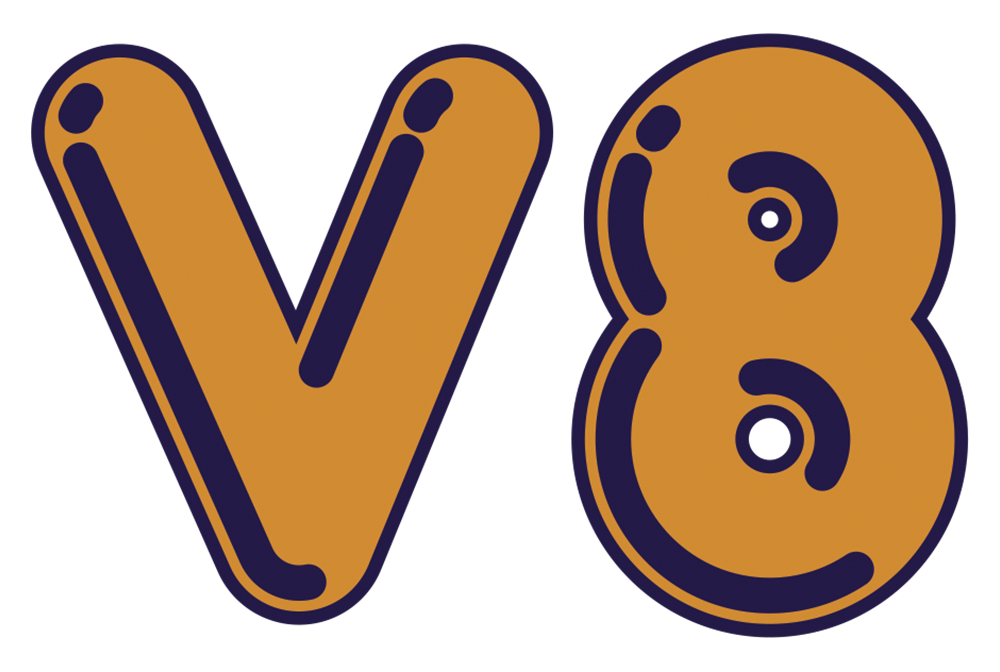
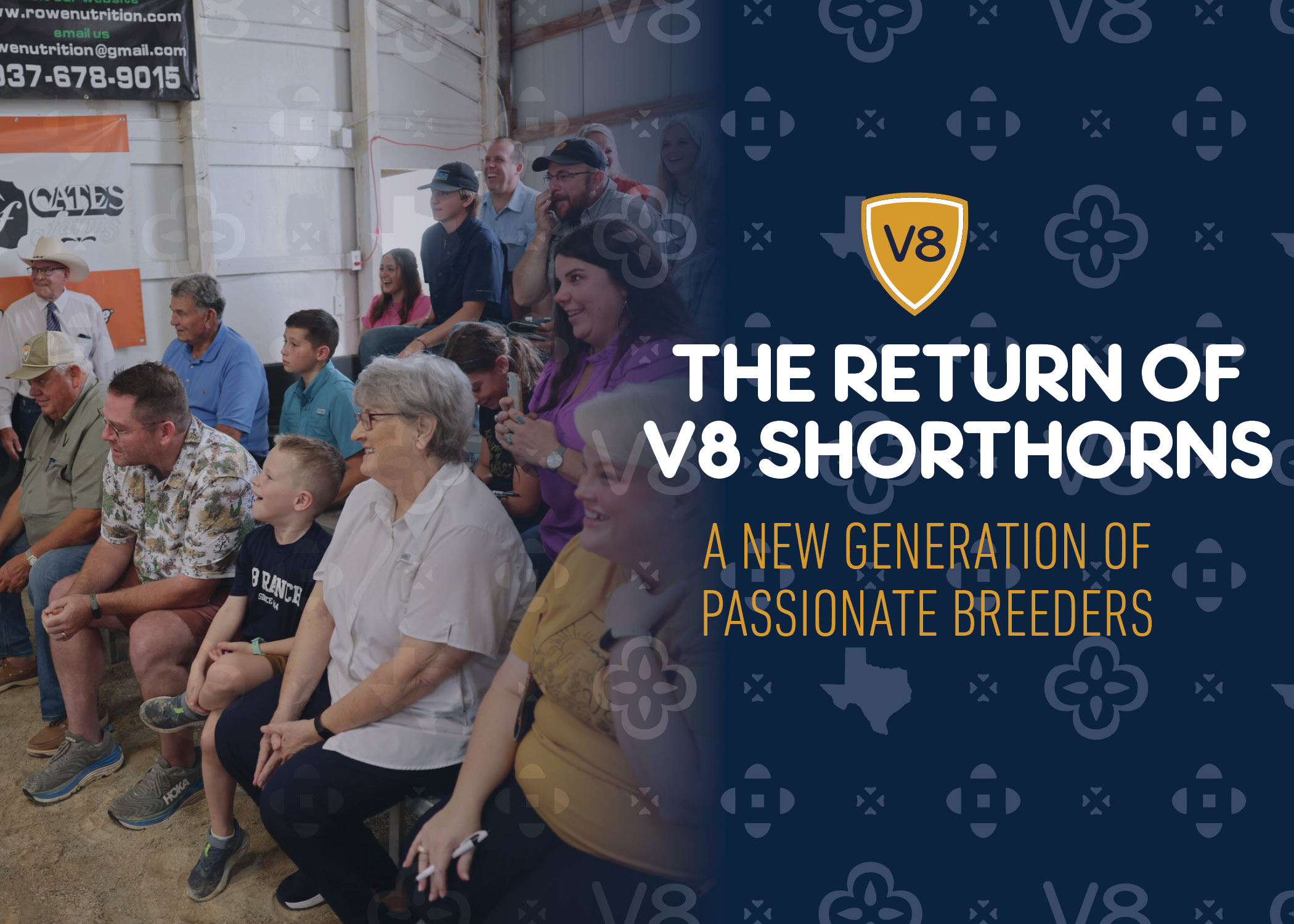
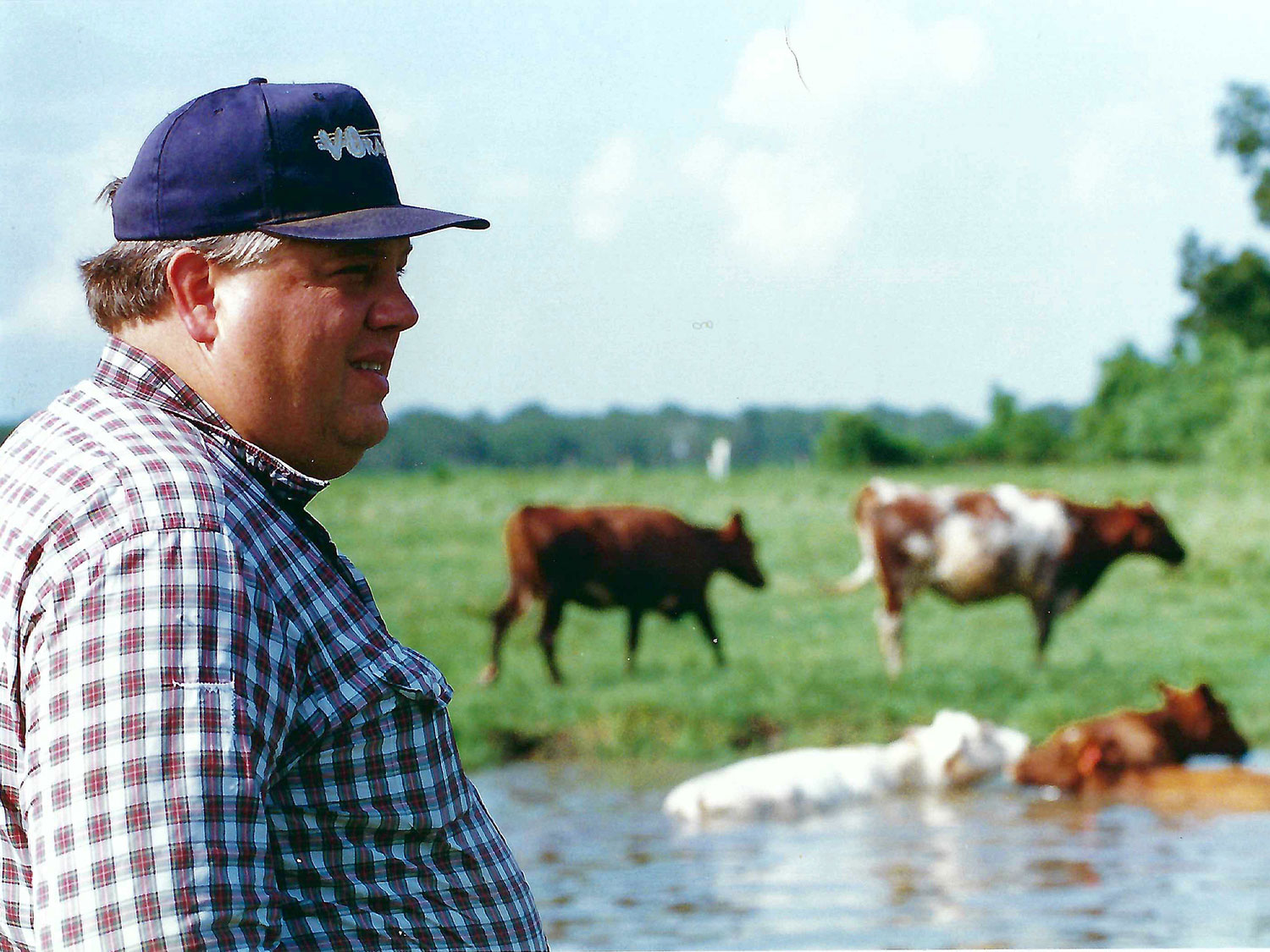
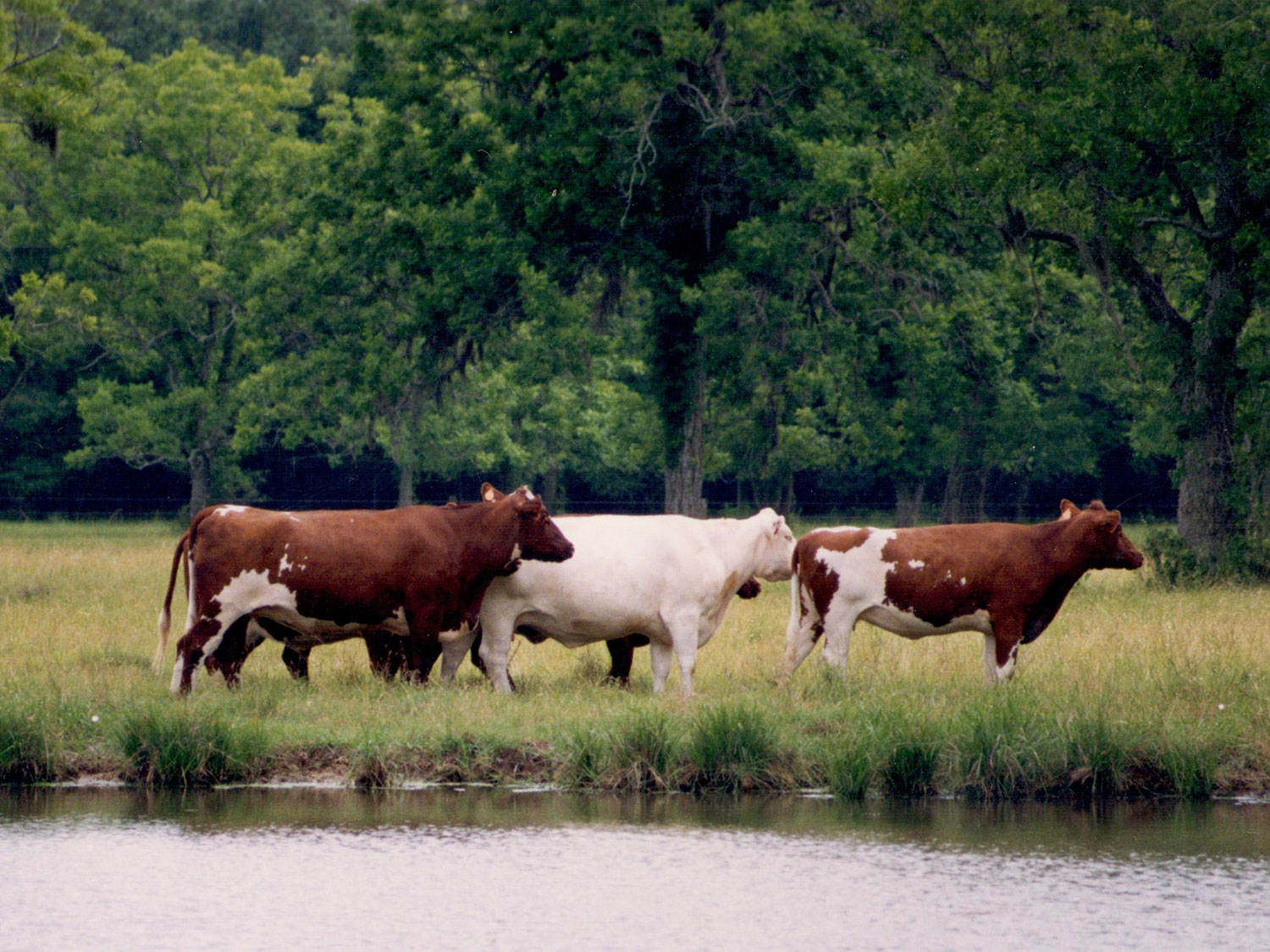
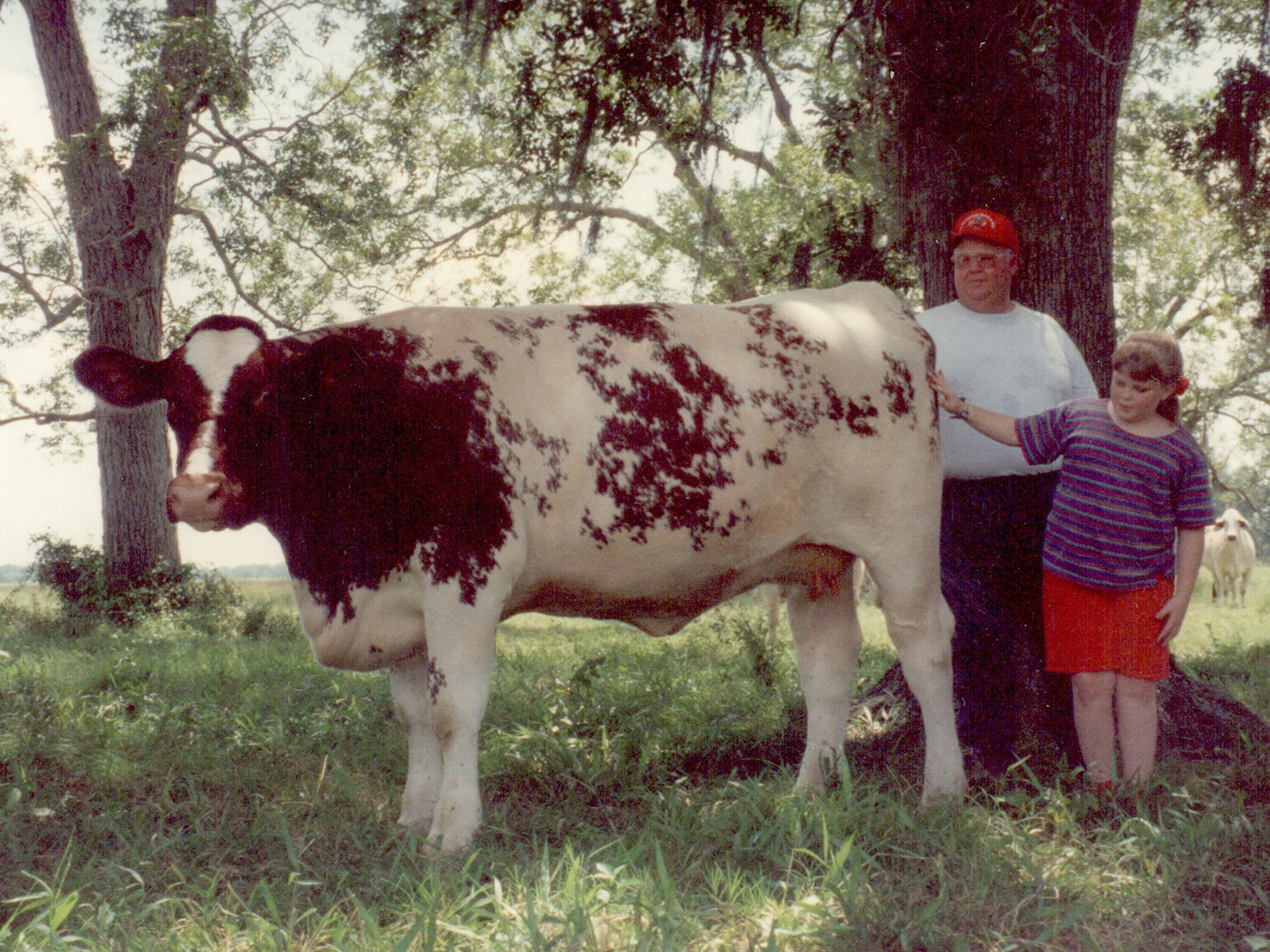
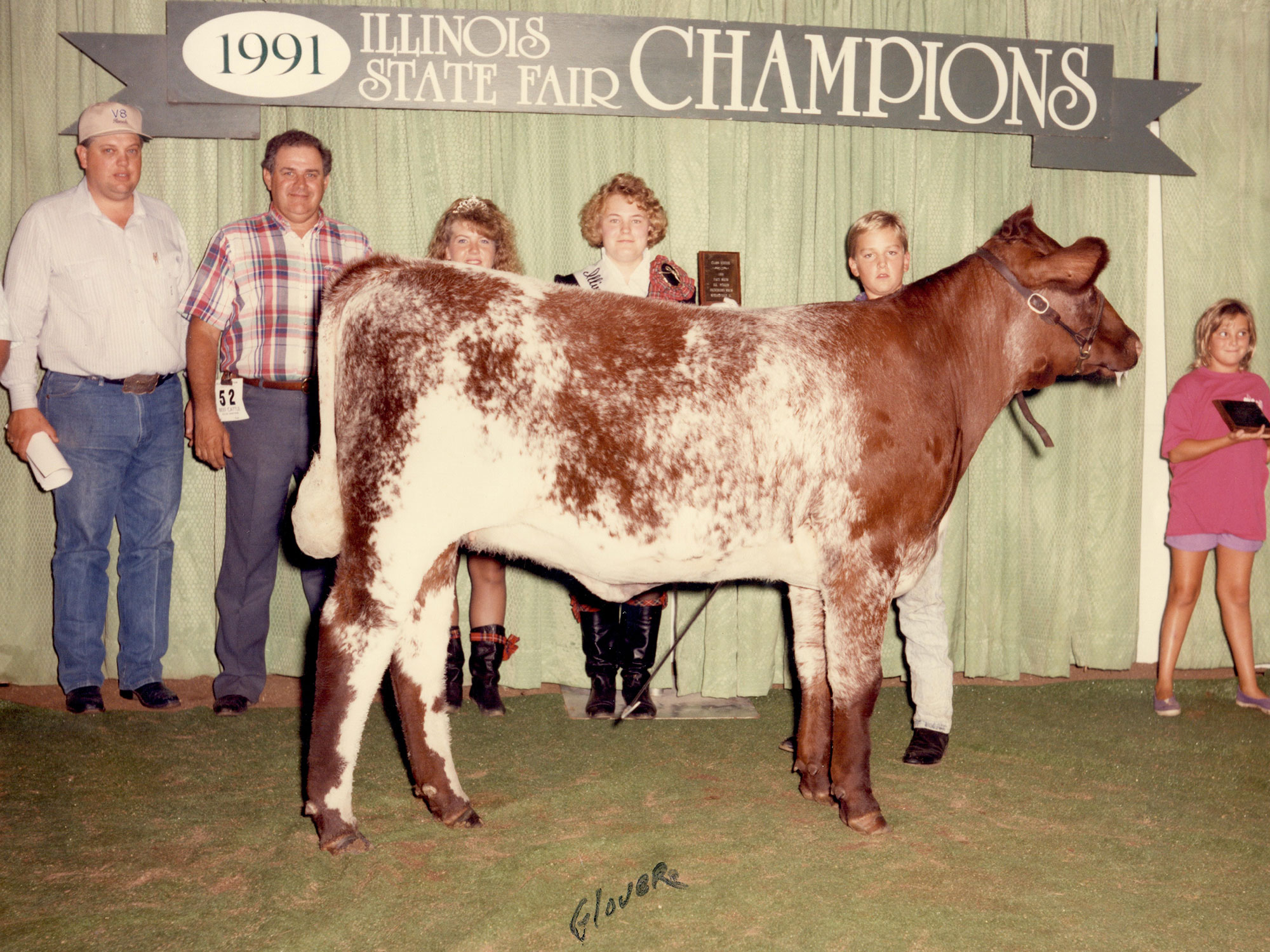
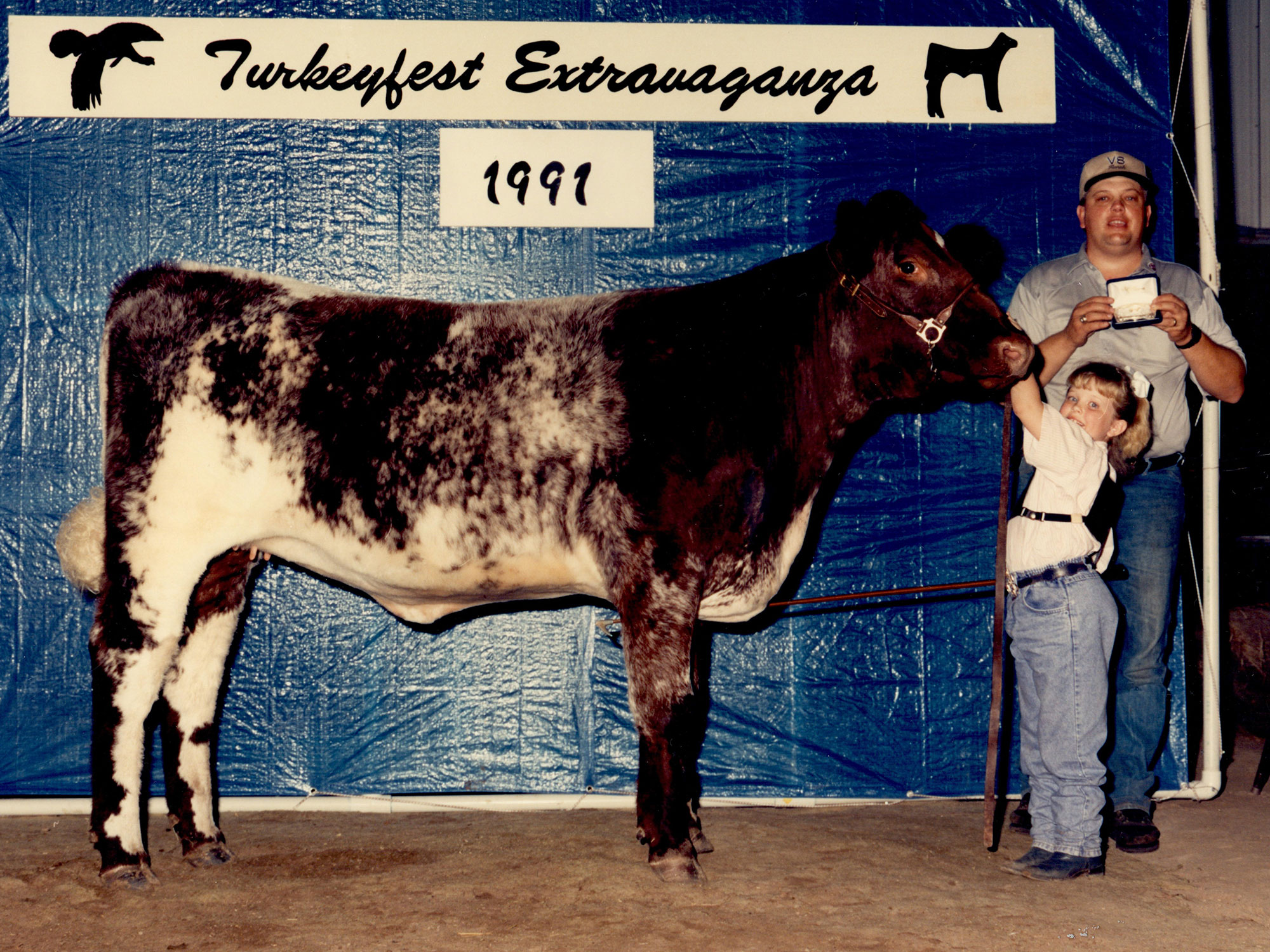
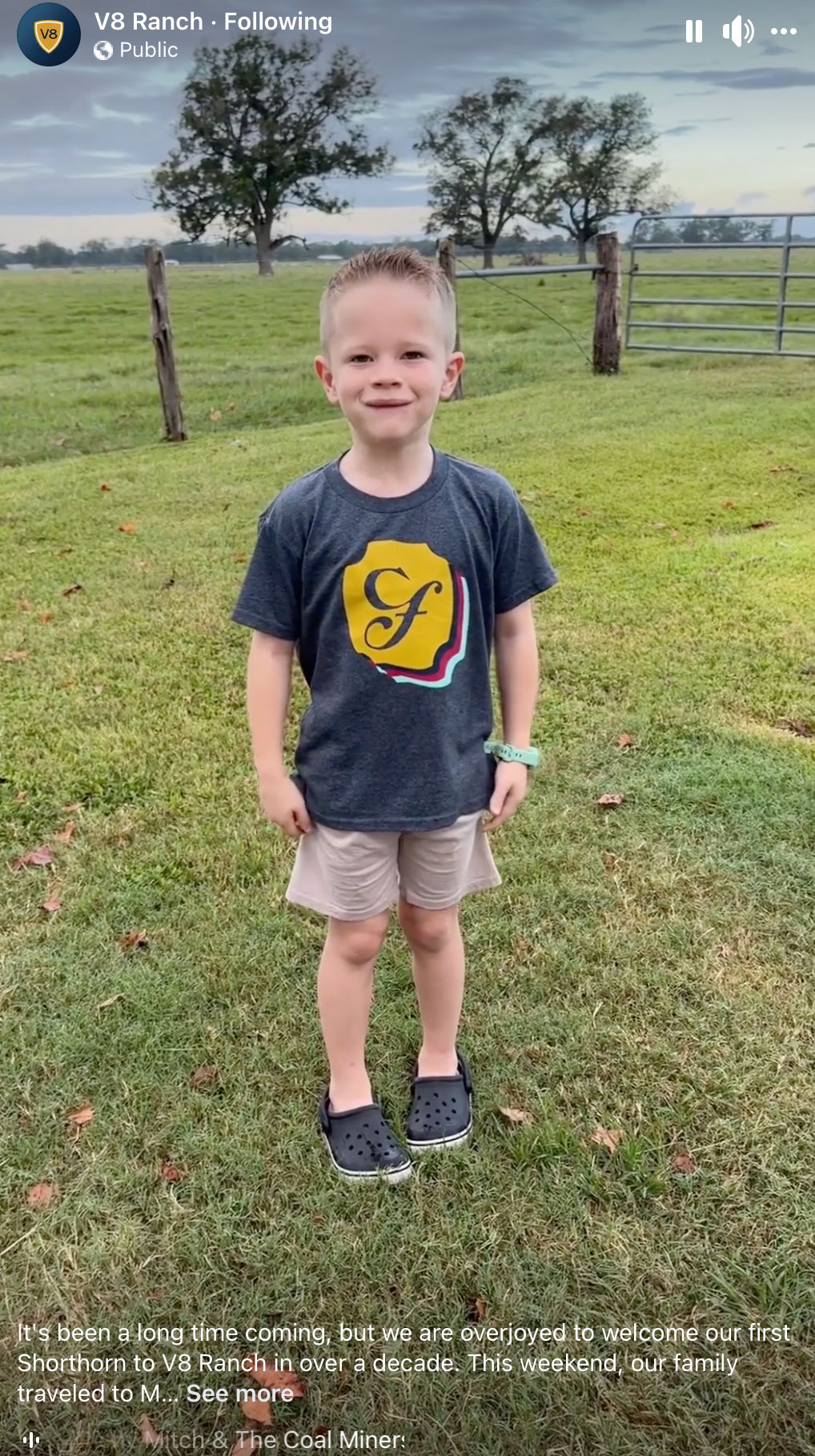
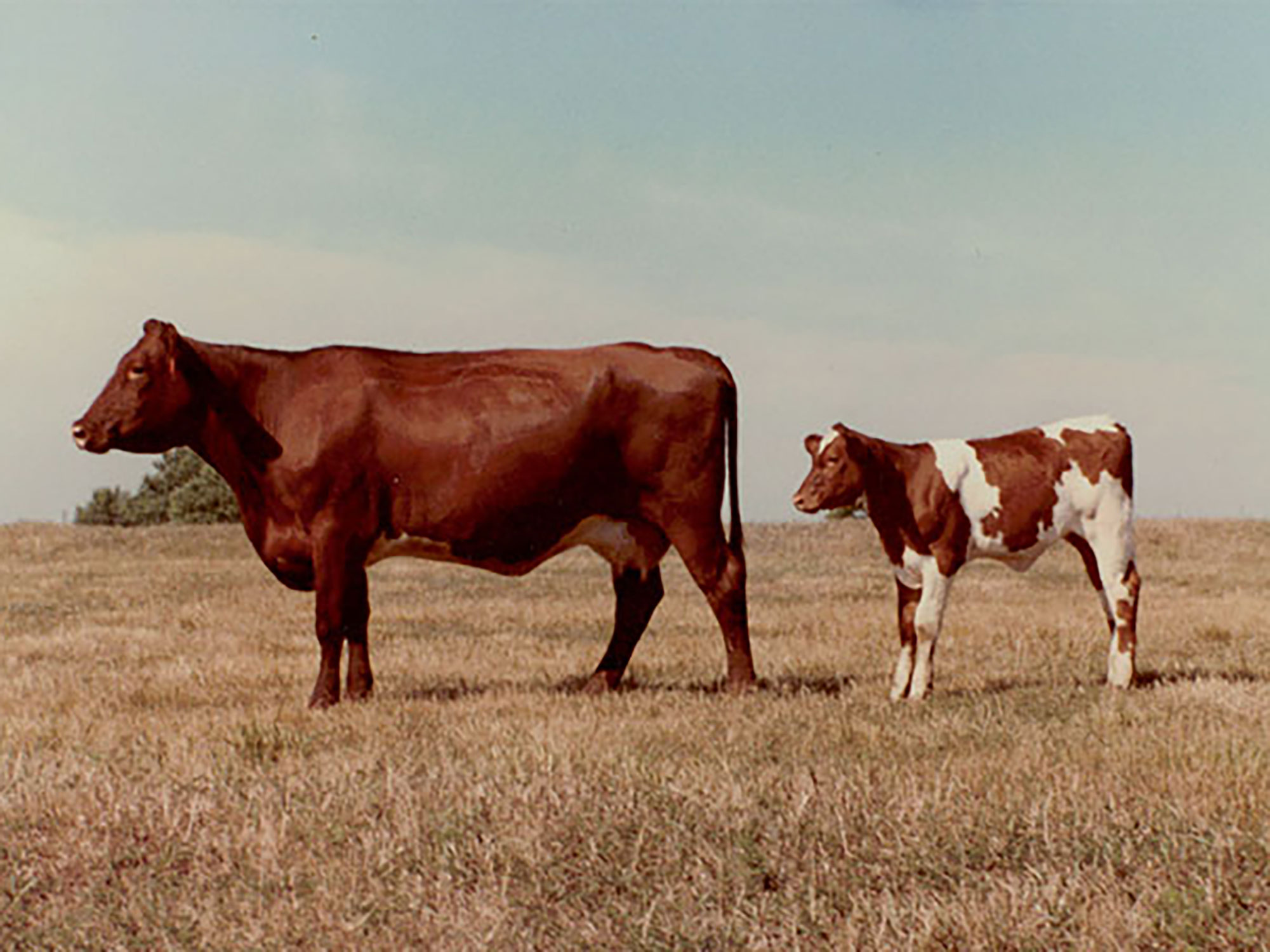
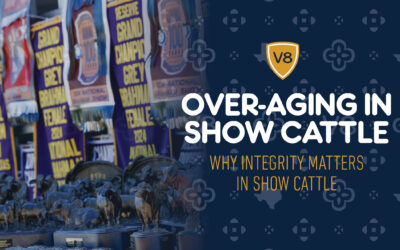
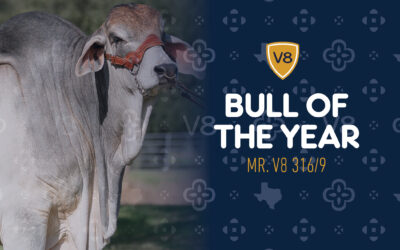
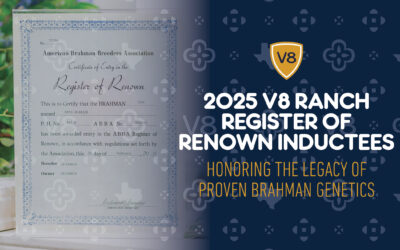

0 Comments